Kellogg's: Analyzing Organizational Performance and Employee Needs
VerifiedAdded on 2020/10/22
|8
|2613
|445
Report
AI Summary
This report analyzes the organizational culture of Kellogg's, examining the relationships between structure, culture, and people. It explores how Kellogg's maintains a positive workplace environment, focusing on employee motivation, role culture, and the application of Maslow's hierarchy of needs to address employee requirements. The report discusses how Kellogg's uses scientific management principles, including monetary reward systems, to improve employee efficiency and retention. It highlights the impact of organizational structure changes on staff behavior, communication, and perception, concluding that a well-defined culture, coupled with effective management concepts, is crucial for organizational performance and employee satisfaction. The analysis also covers the balance between personal and professional life for the employees.
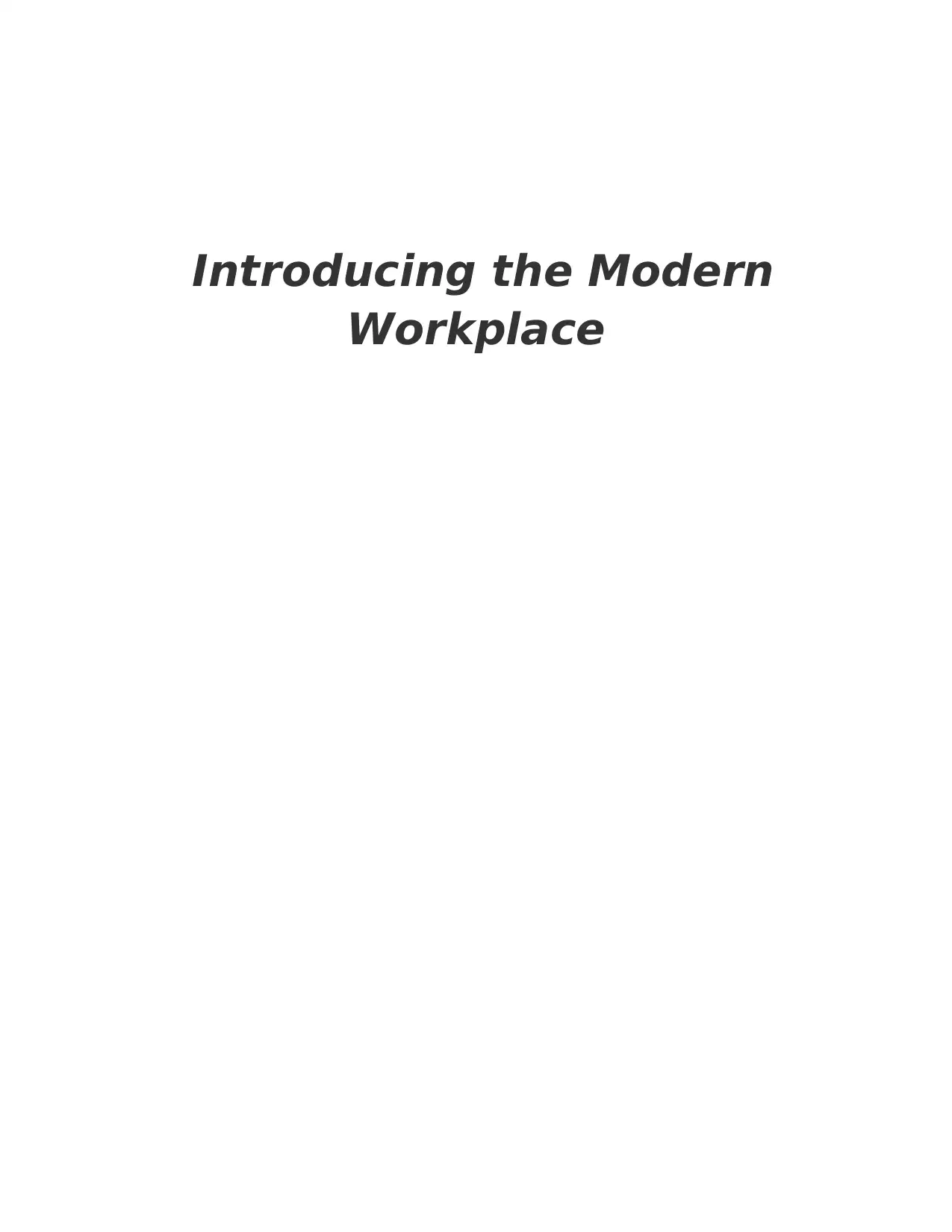
Introducing the Modern
Workplace
Workplace
Paraphrase This Document
Need a fresh take? Get an instant paraphrase of this document with our AI Paraphraser
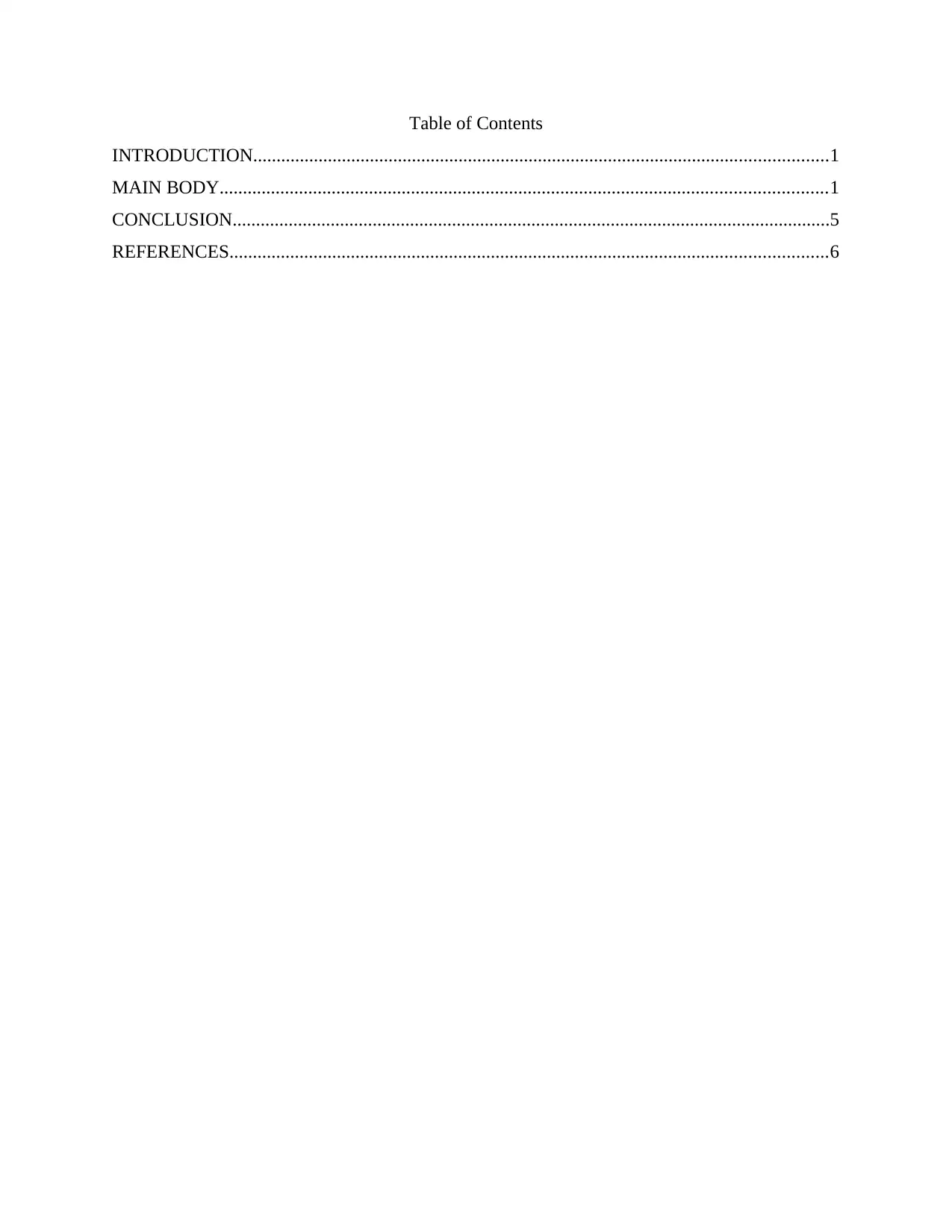
Table of Contents
INTRODUCTION...........................................................................................................................1
MAIN BODY..................................................................................................................................1
CONCLUSION................................................................................................................................5
REFERENCES................................................................................................................................6
INTRODUCTION...........................................................................................................................1
MAIN BODY..................................................................................................................................1
CONCLUSION................................................................................................................................5
REFERENCES................................................................................................................................6
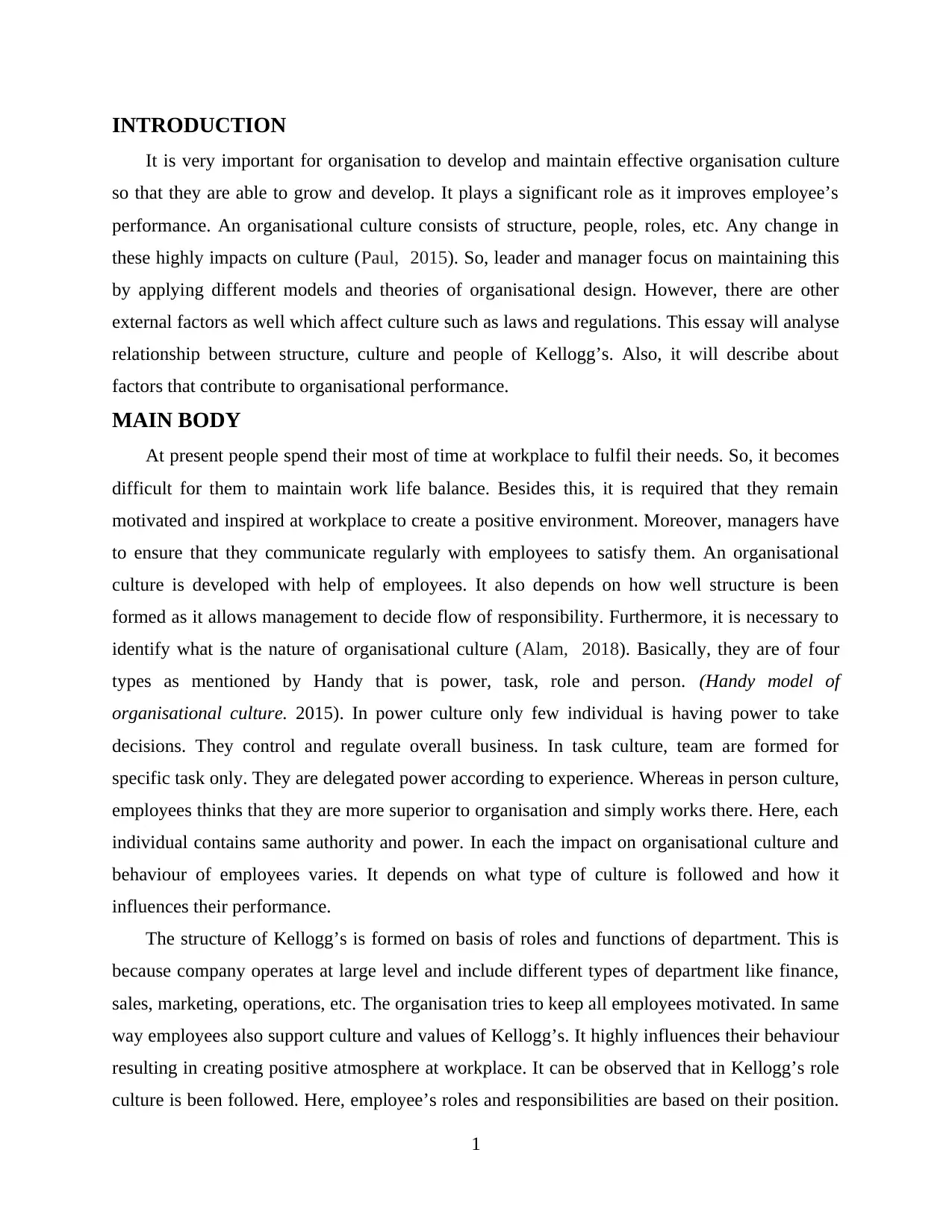
INTRODUCTION
It is very important for organisation to develop and maintain effective organisation culture
so that they are able to grow and develop. It plays a significant role as it improves employee’s
performance. An organisational culture consists of structure, people, roles, etc. Any change in
these highly impacts on culture (Paul, 2015). So, leader and manager focus on maintaining this
by applying different models and theories of organisational design. However, there are other
external factors as well which affect culture such as laws and regulations. This essay will analyse
relationship between structure, culture and people of Kellogg’s. Also, it will describe about
factors that contribute to organisational performance.
MAIN BODY
At present people spend their most of time at workplace to fulfil their needs. So, it becomes
difficult for them to maintain work life balance. Besides this, it is required that they remain
motivated and inspired at workplace to create a positive environment. Moreover, managers have
to ensure that they communicate regularly with employees to satisfy them. An organisational
culture is developed with help of employees. It also depends on how well structure is been
formed as it allows management to decide flow of responsibility. Furthermore, it is necessary to
identify what is the nature of organisational culture (Alam, 2018). Basically, they are of four
types as mentioned by Handy that is power, task, role and person. (Handy model of
organisational culture. 2015). In power culture only few individual is having power to take
decisions. They control and regulate overall business. In task culture, team are formed for
specific task only. They are delegated power according to experience. Whereas in person culture,
employees thinks that they are more superior to organisation and simply works there. Here, each
individual contains same authority and power. In each the impact on organisational culture and
behaviour of employees varies. It depends on what type of culture is followed and how it
influences their performance.
The structure of Kellogg’s is formed on basis of roles and functions of department. This is
because company operates at large level and include different types of department like finance,
sales, marketing, operations, etc. The organisation tries to keep all employees motivated. In same
way employees also support culture and values of Kellogg’s. It highly influences their behaviour
resulting in creating positive atmosphere at workplace. It can be observed that in Kellogg’s role
culture is been followed. Here, employee’s roles and responsibilities are based on their position.
1
It is very important for organisation to develop and maintain effective organisation culture
so that they are able to grow and develop. It plays a significant role as it improves employee’s
performance. An organisational culture consists of structure, people, roles, etc. Any change in
these highly impacts on culture (Paul, 2015). So, leader and manager focus on maintaining this
by applying different models and theories of organisational design. However, there are other
external factors as well which affect culture such as laws and regulations. This essay will analyse
relationship between structure, culture and people of Kellogg’s. Also, it will describe about
factors that contribute to organisational performance.
MAIN BODY
At present people spend their most of time at workplace to fulfil their needs. So, it becomes
difficult for them to maintain work life balance. Besides this, it is required that they remain
motivated and inspired at workplace to create a positive environment. Moreover, managers have
to ensure that they communicate regularly with employees to satisfy them. An organisational
culture is developed with help of employees. It also depends on how well structure is been
formed as it allows management to decide flow of responsibility. Furthermore, it is necessary to
identify what is the nature of organisational culture (Alam, 2018). Basically, they are of four
types as mentioned by Handy that is power, task, role and person. (Handy model of
organisational culture. 2015). In power culture only few individual is having power to take
decisions. They control and regulate overall business. In task culture, team are formed for
specific task only. They are delegated power according to experience. Whereas in person culture,
employees thinks that they are more superior to organisation and simply works there. Here, each
individual contains same authority and power. In each the impact on organisational culture and
behaviour of employees varies. It depends on what type of culture is followed and how it
influences their performance.
The structure of Kellogg’s is formed on basis of roles and functions of department. This is
because company operates at large level and include different types of department like finance,
sales, marketing, operations, etc. The organisation tries to keep all employees motivated. In same
way employees also support culture and values of Kellogg’s. It highly influences their behaviour
resulting in creating positive atmosphere at workplace. It can be observed that in Kellogg’s role
culture is been followed. Here, employee’s roles and responsibilities are based on their position.
1
⊘ This is a preview!⊘
Do you want full access?
Subscribe today to unlock all pages.

Trusted by 1+ million students worldwide
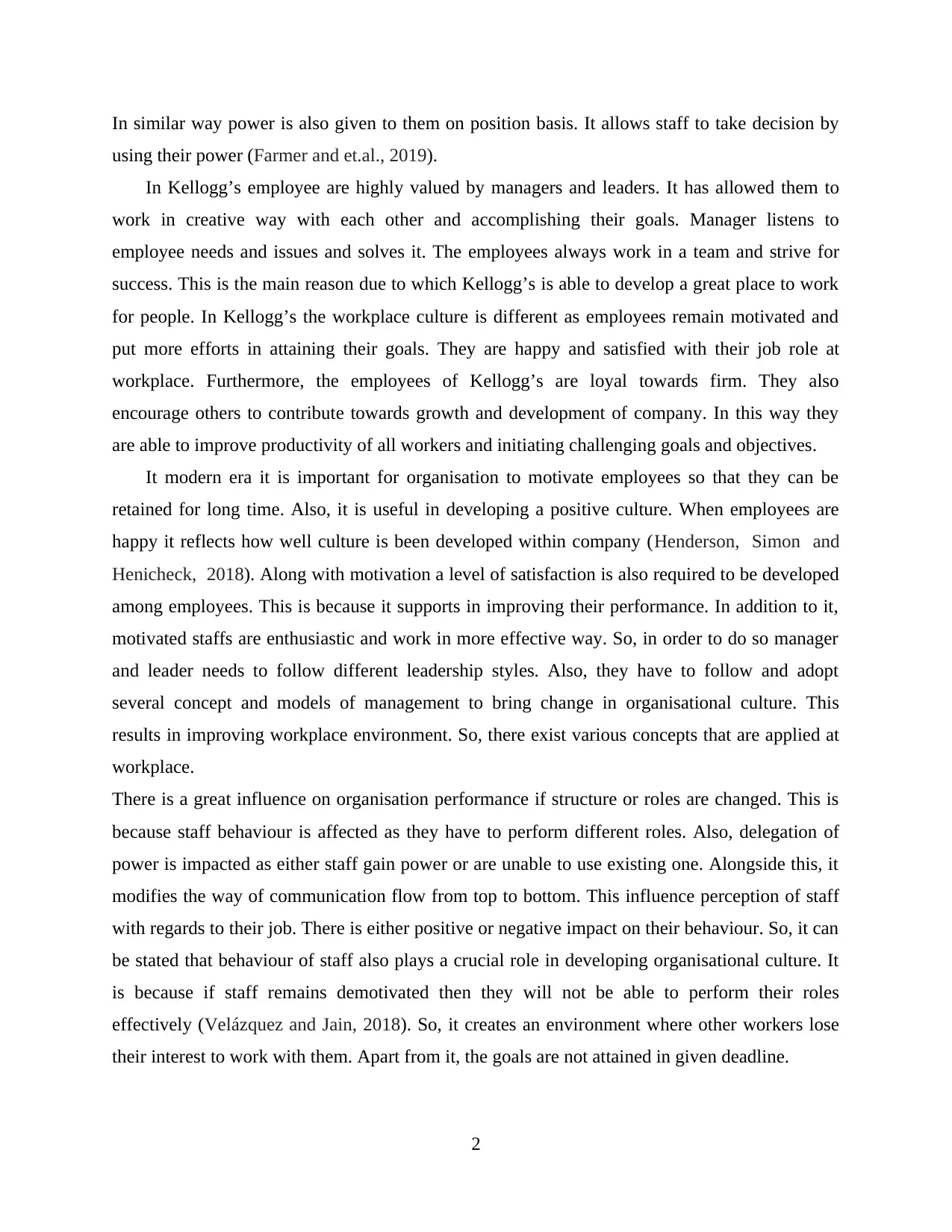
In similar way power is also given to them on position basis. It allows staff to take decision by
using their power (Farmer and et.al., 2019).
In Kellogg’s employee are highly valued by managers and leaders. It has allowed them to
work in creative way with each other and accomplishing their goals. Manager listens to
employee needs and issues and solves it. The employees always work in a team and strive for
success. This is the main reason due to which Kellogg’s is able to develop a great place to work
for people. In Kellogg’s the workplace culture is different as employees remain motivated and
put more efforts in attaining their goals. They are happy and satisfied with their job role at
workplace. Furthermore, the employees of Kellogg’s are loyal towards firm. They also
encourage others to contribute towards growth and development of company. In this way they
are able to improve productivity of all workers and initiating challenging goals and objectives.
It modern era it is important for organisation to motivate employees so that they can be
retained for long time. Also, it is useful in developing a positive culture. When employees are
happy it reflects how well culture is been developed within company (Henderson, Simon and
Henicheck, 2018). Along with motivation a level of satisfaction is also required to be developed
among employees. This is because it supports in improving their performance. In addition to it,
motivated staffs are enthusiastic and work in more effective way. So, in order to do so manager
and leader needs to follow different leadership styles. Also, they have to follow and adopt
several concept and models of management to bring change in organisational culture. This
results in improving workplace environment. So, there exist various concepts that are applied at
workplace.
There is a great influence on organisation performance if structure or roles are changed. This is
because staff behaviour is affected as they have to perform different roles. Also, delegation of
power is impacted as either staff gain power or are unable to use existing one. Alongside this, it
modifies the way of communication flow from top to bottom. This influence perception of staff
with regards to their job. There is either positive or negative impact on their behaviour. So, it can
be stated that behaviour of staff also plays a crucial role in developing organisational culture. It
is because if staff remains demotivated then they will not be able to perform their roles
effectively (Velázquez and Jain, 2018). So, it creates an environment where other workers lose
their interest to work with them. Apart from it, the goals are not attained in given deadline.
2
using their power (Farmer and et.al., 2019).
In Kellogg’s employee are highly valued by managers and leaders. It has allowed them to
work in creative way with each other and accomplishing their goals. Manager listens to
employee needs and issues and solves it. The employees always work in a team and strive for
success. This is the main reason due to which Kellogg’s is able to develop a great place to work
for people. In Kellogg’s the workplace culture is different as employees remain motivated and
put more efforts in attaining their goals. They are happy and satisfied with their job role at
workplace. Furthermore, the employees of Kellogg’s are loyal towards firm. They also
encourage others to contribute towards growth and development of company. In this way they
are able to improve productivity of all workers and initiating challenging goals and objectives.
It modern era it is important for organisation to motivate employees so that they can be
retained for long time. Also, it is useful in developing a positive culture. When employees are
happy it reflects how well culture is been developed within company (Henderson, Simon and
Henicheck, 2018). Along with motivation a level of satisfaction is also required to be developed
among employees. This is because it supports in improving their performance. In addition to it,
motivated staffs are enthusiastic and work in more effective way. So, in order to do so manager
and leader needs to follow different leadership styles. Also, they have to follow and adopt
several concept and models of management to bring change in organisational culture. This
results in improving workplace environment. So, there exist various concepts that are applied at
workplace.
There is a great influence on organisation performance if structure or roles are changed. This is
because staff behaviour is affected as they have to perform different roles. Also, delegation of
power is impacted as either staff gain power or are unable to use existing one. Alongside this, it
modifies the way of communication flow from top to bottom. This influence perception of staff
with regards to their job. There is either positive or negative impact on their behaviour. So, it can
be stated that behaviour of staff also plays a crucial role in developing organisational culture. It
is because if staff remains demotivated then they will not be able to perform their roles
effectively (Velázquez and Jain, 2018). So, it creates an environment where other workers lose
their interest to work with them. Apart from it, the goals are not attained in given deadline.
2
Paraphrase This Document
Need a fresh take? Get an instant paraphrase of this document with our AI Paraphraser
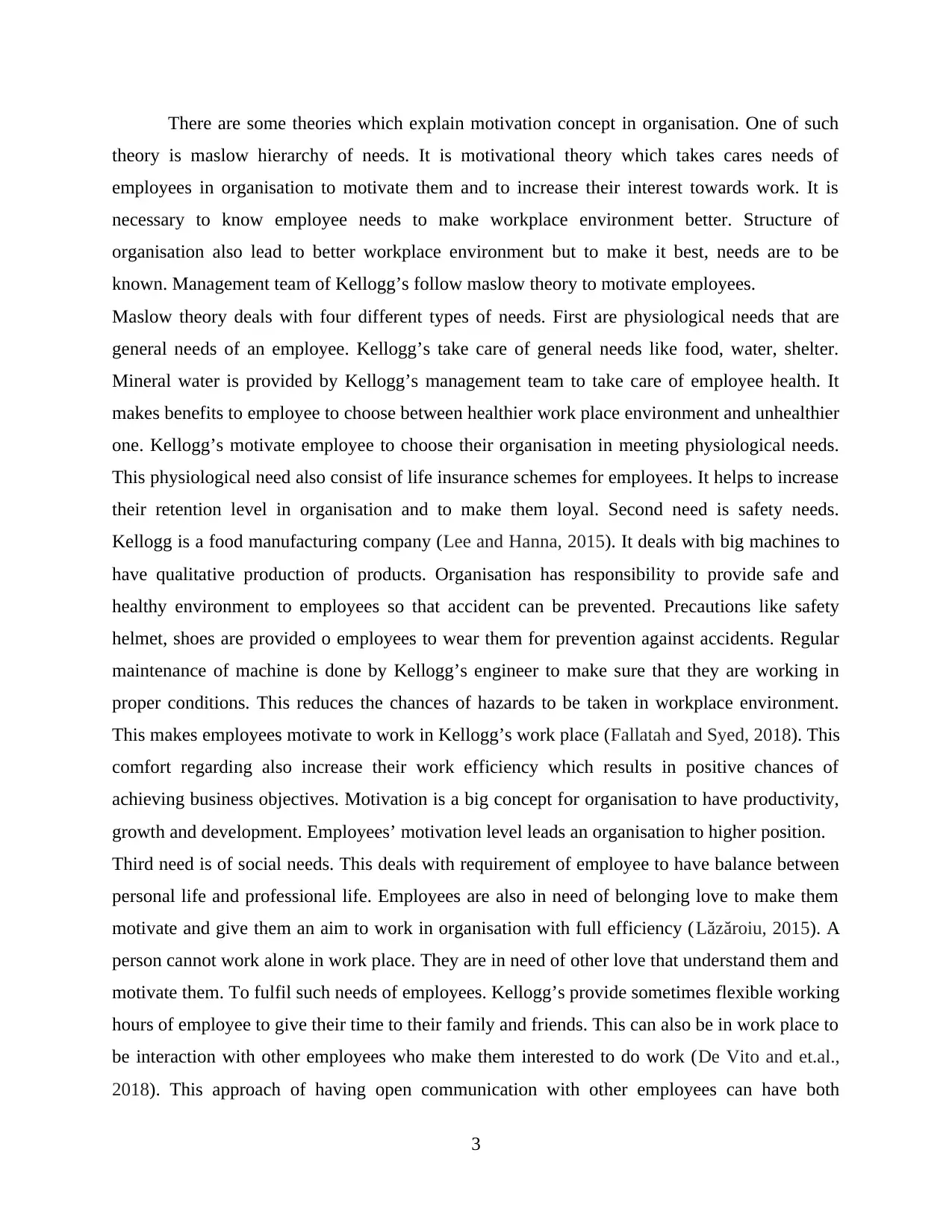
There are some theories which explain motivation concept in organisation. One of such
theory is maslow hierarchy of needs. It is motivational theory which takes cares needs of
employees in organisation to motivate them and to increase their interest towards work. It is
necessary to know employee needs to make workplace environment better. Structure of
organisation also lead to better workplace environment but to make it best, needs are to be
known. Management team of Kellogg’s follow maslow theory to motivate employees.
Maslow theory deals with four different types of needs. First are physiological needs that are
general needs of an employee. Kellogg’s take care of general needs like food, water, shelter.
Mineral water is provided by Kellogg’s management team to take care of employee health. It
makes benefits to employee to choose between healthier work place environment and unhealthier
one. Kellogg’s motivate employee to choose their organisation in meeting physiological needs.
This physiological need also consist of life insurance schemes for employees. It helps to increase
their retention level in organisation and to make them loyal. Second need is safety needs.
Kellogg is a food manufacturing company (Lee and Hanna, 2015). It deals with big machines to
have qualitative production of products. Organisation has responsibility to provide safe and
healthy environment to employees so that accident can be prevented. Precautions like safety
helmet, shoes are provided o employees to wear them for prevention against accidents. Regular
maintenance of machine is done by Kellogg’s engineer to make sure that they are working in
proper conditions. This reduces the chances of hazards to be taken in workplace environment.
This makes employees motivate to work in Kellogg’s work place (Fallatah and Syed, 2018). This
comfort regarding also increase their work efficiency which results in positive chances of
achieving business objectives. Motivation is a big concept for organisation to have productivity,
growth and development. Employees’ motivation level leads an organisation to higher position.
Third need is of social needs. This deals with requirement of employee to have balance between
personal life and professional life. Employees are also in need of belonging love to make them
motivate and give them an aim to work in organisation with full efficiency (Lăzăroiu, 2015). A
person cannot work alone in work place. They are in need of other love that understand them and
motivate them. To fulfil such needs of employees. Kellogg’s provide sometimes flexible working
hours of employee to give their time to their family and friends. This can also be in work place to
be interaction with other employees who make them interested to do work (De Vito and et.al.,
2018). This approach of having open communication with other employees can have both
3
theory is maslow hierarchy of needs. It is motivational theory which takes cares needs of
employees in organisation to motivate them and to increase their interest towards work. It is
necessary to know employee needs to make workplace environment better. Structure of
organisation also lead to better workplace environment but to make it best, needs are to be
known. Management team of Kellogg’s follow maslow theory to motivate employees.
Maslow theory deals with four different types of needs. First are physiological needs that are
general needs of an employee. Kellogg’s take care of general needs like food, water, shelter.
Mineral water is provided by Kellogg’s management team to take care of employee health. It
makes benefits to employee to choose between healthier work place environment and unhealthier
one. Kellogg’s motivate employee to choose their organisation in meeting physiological needs.
This physiological need also consist of life insurance schemes for employees. It helps to increase
their retention level in organisation and to make them loyal. Second need is safety needs.
Kellogg is a food manufacturing company (Lee and Hanna, 2015). It deals with big machines to
have qualitative production of products. Organisation has responsibility to provide safe and
healthy environment to employees so that accident can be prevented. Precautions like safety
helmet, shoes are provided o employees to wear them for prevention against accidents. Regular
maintenance of machine is done by Kellogg’s engineer to make sure that they are working in
proper conditions. This reduces the chances of hazards to be taken in workplace environment.
This makes employees motivate to work in Kellogg’s work place (Fallatah and Syed, 2018). This
comfort regarding also increase their work efficiency which results in positive chances of
achieving business objectives. Motivation is a big concept for organisation to have productivity,
growth and development. Employees’ motivation level leads an organisation to higher position.
Third need is of social needs. This deals with requirement of employee to have balance between
personal life and professional life. Employees are also in need of belonging love to make them
motivate and give them an aim to work in organisation with full efficiency (Lăzăroiu, 2015). A
person cannot work alone in work place. They are in need of other love that understand them and
motivate them. To fulfil such needs of employees. Kellogg’s provide sometimes flexible working
hours of employee to give their time to their family and friends. This can also be in work place to
be interaction with other employees who make them interested to do work (De Vito and et.al.,
2018). This approach of having open communication with other employees can have both
3
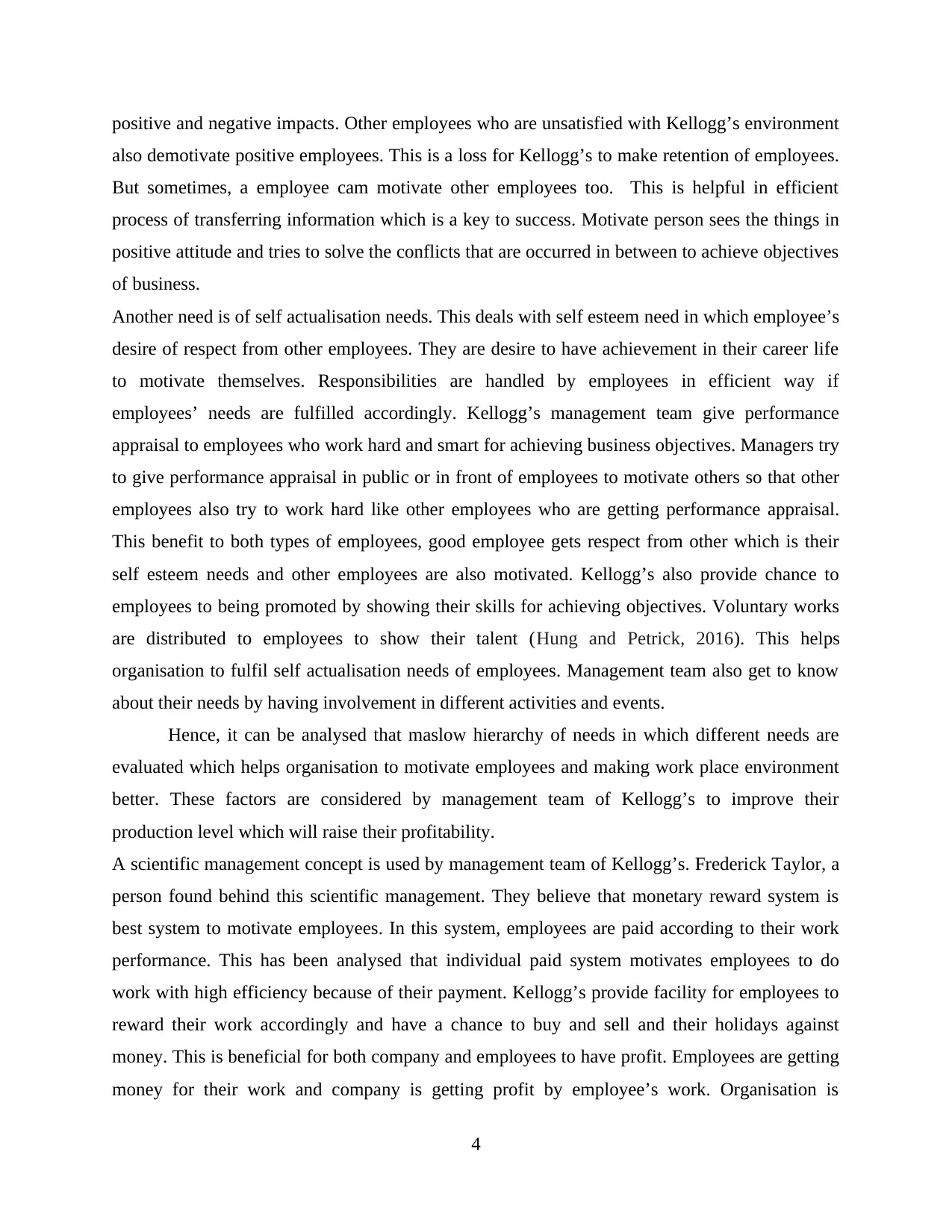
positive and negative impacts. Other employees who are unsatisfied with Kellogg’s environment
also demotivate positive employees. This is a loss for Kellogg’s to make retention of employees.
But sometimes, a employee cam motivate other employees too. This is helpful in efficient
process of transferring information which is a key to success. Motivate person sees the things in
positive attitude and tries to solve the conflicts that are occurred in between to achieve objectives
of business.
Another need is of self actualisation needs. This deals with self esteem need in which employee’s
desire of respect from other employees. They are desire to have achievement in their career life
to motivate themselves. Responsibilities are handled by employees in efficient way if
employees’ needs are fulfilled accordingly. Kellogg’s management team give performance
appraisal to employees who work hard and smart for achieving business objectives. Managers try
to give performance appraisal in public or in front of employees to motivate others so that other
employees also try to work hard like other employees who are getting performance appraisal.
This benefit to both types of employees, good employee gets respect from other which is their
self esteem needs and other employees are also motivated. Kellogg’s also provide chance to
employees to being promoted by showing their skills for achieving objectives. Voluntary works
are distributed to employees to show their talent (Hung and Petrick, 2016). This helps
organisation to fulfil self actualisation needs of employees. Management team also get to know
about their needs by having involvement in different activities and events.
Hence, it can be analysed that maslow hierarchy of needs in which different needs are
evaluated which helps organisation to motivate employees and making work place environment
better. These factors are considered by management team of Kellogg’s to improve their
production level which will raise their profitability.
A scientific management concept is used by management team of Kellogg’s. Frederick Taylor, a
person found behind this scientific management. They believe that monetary reward system is
best system to motivate employees. In this system, employees are paid according to their work
performance. This has been analysed that individual paid system motivates employees to do
work with high efficiency because of their payment. Kellogg’s provide facility for employees to
reward their work accordingly and have a chance to buy and sell and their holidays against
money. This is beneficial for both company and employees to have profit. Employees are getting
money for their work and company is getting profit by employee’s work. Organisation is
4
also demotivate positive employees. This is a loss for Kellogg’s to make retention of employees.
But sometimes, a employee cam motivate other employees too. This is helpful in efficient
process of transferring information which is a key to success. Motivate person sees the things in
positive attitude and tries to solve the conflicts that are occurred in between to achieve objectives
of business.
Another need is of self actualisation needs. This deals with self esteem need in which employee’s
desire of respect from other employees. They are desire to have achievement in their career life
to motivate themselves. Responsibilities are handled by employees in efficient way if
employees’ needs are fulfilled accordingly. Kellogg’s management team give performance
appraisal to employees who work hard and smart for achieving business objectives. Managers try
to give performance appraisal in public or in front of employees to motivate others so that other
employees also try to work hard like other employees who are getting performance appraisal.
This benefit to both types of employees, good employee gets respect from other which is their
self esteem needs and other employees are also motivated. Kellogg’s also provide chance to
employees to being promoted by showing their skills for achieving objectives. Voluntary works
are distributed to employees to show their talent (Hung and Petrick, 2016). This helps
organisation to fulfil self actualisation needs of employees. Management team also get to know
about their needs by having involvement in different activities and events.
Hence, it can be analysed that maslow hierarchy of needs in which different needs are
evaluated which helps organisation to motivate employees and making work place environment
better. These factors are considered by management team of Kellogg’s to improve their
production level which will raise their profitability.
A scientific management concept is used by management team of Kellogg’s. Frederick Taylor, a
person found behind this scientific management. They believe that monetary reward system is
best system to motivate employees. In this system, employees are paid according to their work
performance. This has been analysed that individual paid system motivates employees to do
work with high efficiency because of their payment. Kellogg’s provide facility for employees to
reward their work accordingly and have a chance to buy and sell and their holidays against
money. This is beneficial for both company and employees to have profit. Employees are getting
money for their work and company is getting profit by employee’s work. Organisation is
4
⊘ This is a preview!⊘
Do you want full access?
Subscribe today to unlock all pages.

Trusted by 1+ million students worldwide
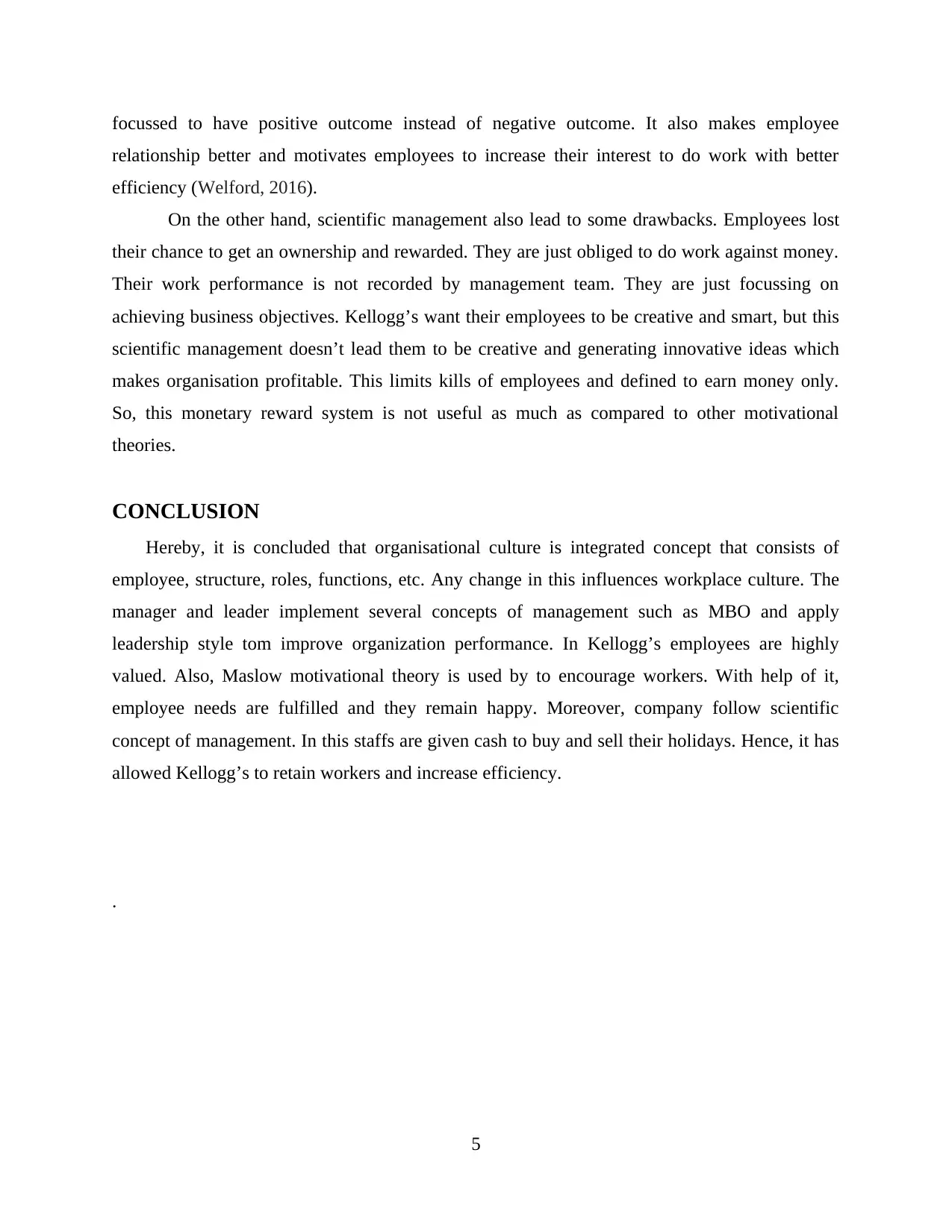
focussed to have positive outcome instead of negative outcome. It also makes employee
relationship better and motivates employees to increase their interest to do work with better
efficiency (Welford, 2016).
On the other hand, scientific management also lead to some drawbacks. Employees lost
their chance to get an ownership and rewarded. They are just obliged to do work against money.
Their work performance is not recorded by management team. They are just focussing on
achieving business objectives. Kellogg’s want their employees to be creative and smart, but this
scientific management doesn’t lead them to be creative and generating innovative ideas which
makes organisation profitable. This limits kills of employees and defined to earn money only.
So, this monetary reward system is not useful as much as compared to other motivational
theories.
CONCLUSION
Hereby, it is concluded that organisational culture is integrated concept that consists of
employee, structure, roles, functions, etc. Any change in this influences workplace culture. The
manager and leader implement several concepts of management such as MBO and apply
leadership style tom improve organization performance. In Kellogg’s employees are highly
valued. Also, Maslow motivational theory is used by to encourage workers. With help of it,
employee needs are fulfilled and they remain happy. Moreover, company follow scientific
concept of management. In this staffs are given cash to buy and sell their holidays. Hence, it has
allowed Kellogg’s to retain workers and increase efficiency.
.
5
relationship better and motivates employees to increase their interest to do work with better
efficiency (Welford, 2016).
On the other hand, scientific management also lead to some drawbacks. Employees lost
their chance to get an ownership and rewarded. They are just obliged to do work against money.
Their work performance is not recorded by management team. They are just focussing on
achieving business objectives. Kellogg’s want their employees to be creative and smart, but this
scientific management doesn’t lead them to be creative and generating innovative ideas which
makes organisation profitable. This limits kills of employees and defined to earn money only.
So, this monetary reward system is not useful as much as compared to other motivational
theories.
CONCLUSION
Hereby, it is concluded that organisational culture is integrated concept that consists of
employee, structure, roles, functions, etc. Any change in this influences workplace culture. The
manager and leader implement several concepts of management such as MBO and apply
leadership style tom improve organization performance. In Kellogg’s employees are highly
valued. Also, Maslow motivational theory is used by to encourage workers. With help of it,
employee needs are fulfilled and they remain happy. Moreover, company follow scientific
concept of management. In this staffs are given cash to buy and sell their holidays. Hence, it has
allowed Kellogg’s to retain workers and increase efficiency.
.
5
Paraphrase This Document
Need a fresh take? Get an instant paraphrase of this document with our AI Paraphraser
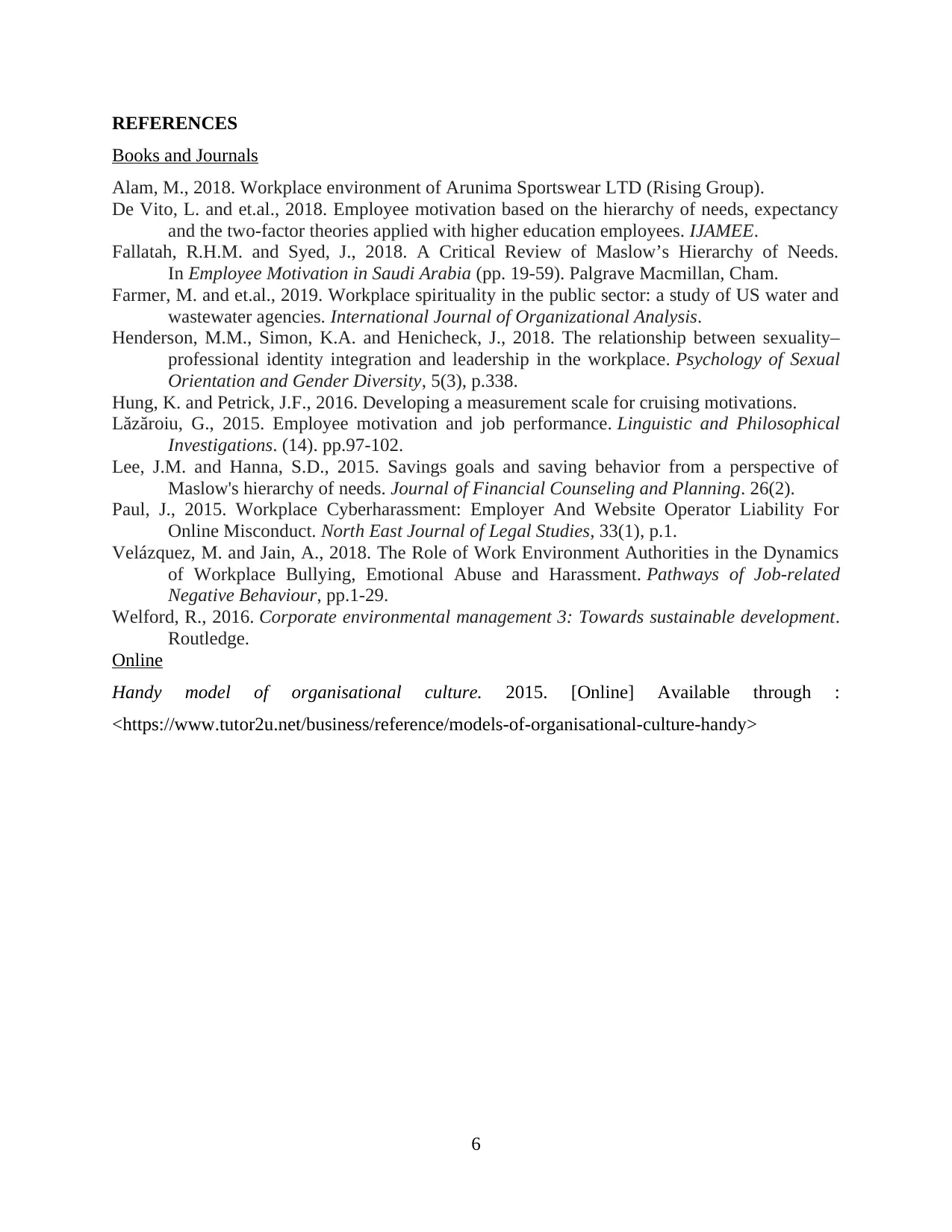
REFERENCES
Books and Journals
Alam, M., 2018. Workplace environment of Arunima Sportswear LTD (Rising Group).
De Vito, L. and et.al., 2018. Employee motivation based on the hierarchy of needs, expectancy
and the two-factor theories applied with higher education employees. IJAMEE.
Fallatah, R.H.M. and Syed, J., 2018. A Critical Review of Maslow’s Hierarchy of Needs.
In Employee Motivation in Saudi Arabia (pp. 19-59). Palgrave Macmillan, Cham.
Farmer, M. and et.al., 2019. Workplace spirituality in the public sector: a study of US water and
wastewater agencies. International Journal of Organizational Analysis.
Henderson, M.M., Simon, K.A. and Henicheck, J., 2018. The relationship between sexuality–
professional identity integration and leadership in the workplace. Psychology of Sexual
Orientation and Gender Diversity, 5(3), p.338.
Hung, K. and Petrick, J.F., 2016. Developing a measurement scale for cruising motivations.
Lăzăroiu, G., 2015. Employee motivation and job performance. Linguistic and Philosophical
Investigations. (14). pp.97-102.
Lee, J.M. and Hanna, S.D., 2015. Savings goals and saving behavior from a perspective of
Maslow's hierarchy of needs. Journal of Financial Counseling and Planning. 26(2).
Paul, J., 2015. Workplace Cyberharassment: Employer And Website Operator Liability For
Online Misconduct. North East Journal of Legal Studies, 33(1), p.1.
Velázquez, M. and Jain, A., 2018. The Role of Work Environment Authorities in the Dynamics
of Workplace Bullying, Emotional Abuse and Harassment. Pathways of Job-related
Negative Behaviour, pp.1-29.
Welford, R., 2016. Corporate environmental management 3: Towards sustainable development.
Routledge.
Online
Handy model of organisational culture. 2015. [Online] Available through :
<https://www.tutor2u.net/business/reference/models-of-organisational-culture-handy>
6
Books and Journals
Alam, M., 2018. Workplace environment of Arunima Sportswear LTD (Rising Group).
De Vito, L. and et.al., 2018. Employee motivation based on the hierarchy of needs, expectancy
and the two-factor theories applied with higher education employees. IJAMEE.
Fallatah, R.H.M. and Syed, J., 2018. A Critical Review of Maslow’s Hierarchy of Needs.
In Employee Motivation in Saudi Arabia (pp. 19-59). Palgrave Macmillan, Cham.
Farmer, M. and et.al., 2019. Workplace spirituality in the public sector: a study of US water and
wastewater agencies. International Journal of Organizational Analysis.
Henderson, M.M., Simon, K.A. and Henicheck, J., 2018. The relationship between sexuality–
professional identity integration and leadership in the workplace. Psychology of Sexual
Orientation and Gender Diversity, 5(3), p.338.
Hung, K. and Petrick, J.F., 2016. Developing a measurement scale for cruising motivations.
Lăzăroiu, G., 2015. Employee motivation and job performance. Linguistic and Philosophical
Investigations. (14). pp.97-102.
Lee, J.M. and Hanna, S.D., 2015. Savings goals and saving behavior from a perspective of
Maslow's hierarchy of needs. Journal of Financial Counseling and Planning. 26(2).
Paul, J., 2015. Workplace Cyberharassment: Employer And Website Operator Liability For
Online Misconduct. North East Journal of Legal Studies, 33(1), p.1.
Velázquez, M. and Jain, A., 2018. The Role of Work Environment Authorities in the Dynamics
of Workplace Bullying, Emotional Abuse and Harassment. Pathways of Job-related
Negative Behaviour, pp.1-29.
Welford, R., 2016. Corporate environmental management 3: Towards sustainable development.
Routledge.
Online
Handy model of organisational culture. 2015. [Online] Available through :
<https://www.tutor2u.net/business/reference/models-of-organisational-culture-handy>
6
1 out of 8
Related Documents
Your All-in-One AI-Powered Toolkit for Academic Success.
+13062052269
info@desklib.com
Available 24*7 on WhatsApp / Email
![[object Object]](/_next/static/media/star-bottom.7253800d.svg)
Unlock your academic potential
Copyright © 2020–2025 A2Z Services. All Rights Reserved. Developed and managed by ZUCOL.





